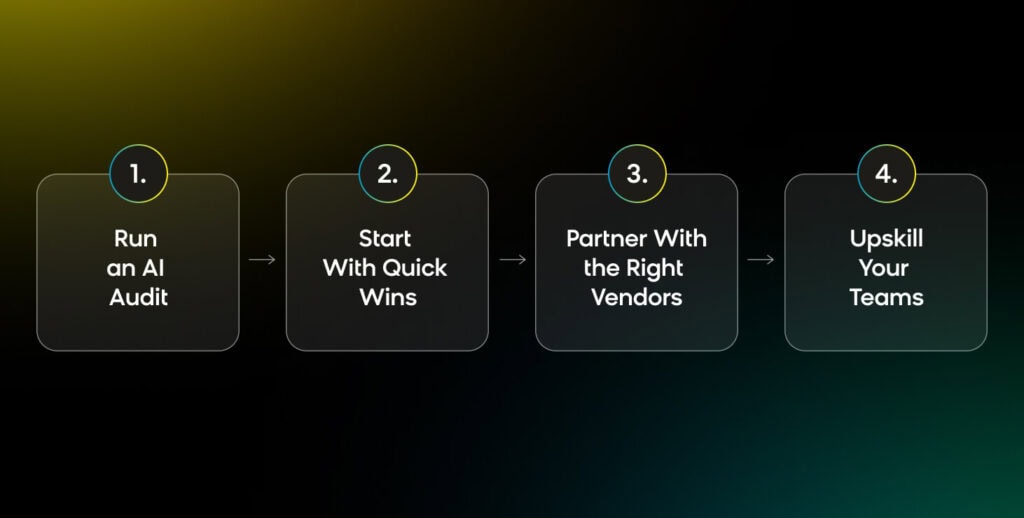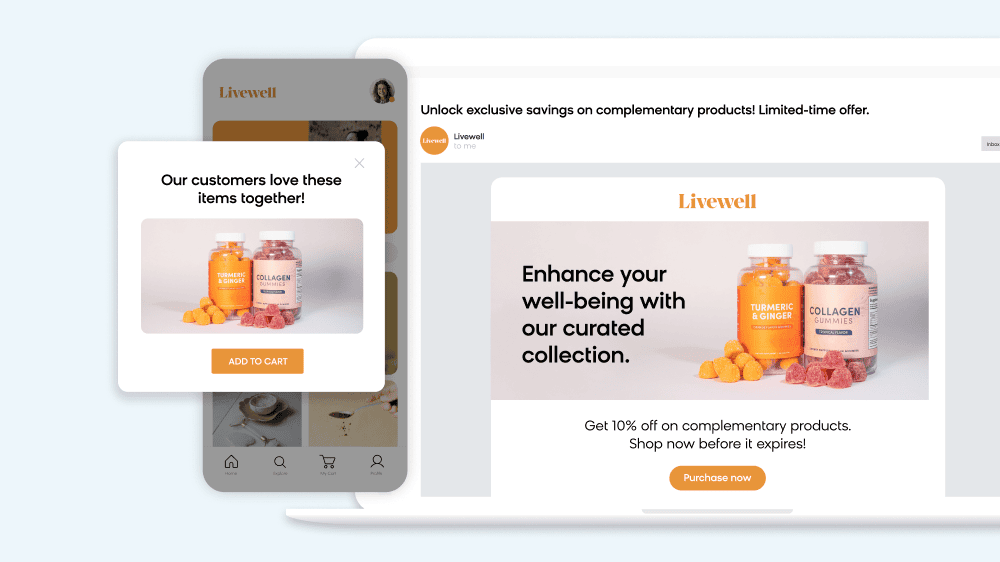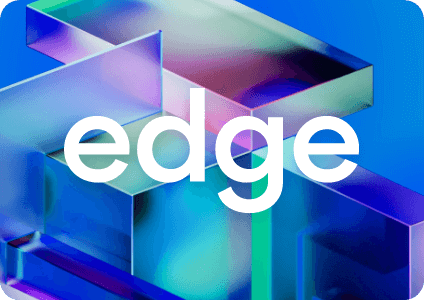The marketing world buzzed with excitement after ChatGPT’s November 2022 debut. Brands rushed to implement generative AI for marketing, with a particular focus on content creation and basic automation. However, most remain stuck generating blog posts, social captions, and email subject lines, missing the real revenue opportunity entirely.
Here’s what’s holding your marketing back: Traditional generative AI creates static outputs that require constant human babysitting. You prompt the system. It spits out content. You manually distribute that content through predetermined channels to predefined segments.
Sure, this delivers efficiency gains. But efficiency isn’t transformation — and it won’t drive the revenue growth your business needs.
The future belongs to agentic AI systems that act autonomously on commerce signals, orchestrating real-time customer journeys without human intervention. These systems predict intent, make strategic decisions, and execute coordinated campaigns across channels while you sleep. Think of it as upgrading from a content assistant to an always-on marketing director who never misses a signal.
Let’s explore how agentic AI is already delivering this transformation for leading brands.
Why Content Generation Hits Revenue Walls
The 2022-2024 GenAI Wave: Productivity Without Profitability
Most marketing teams focused on content generation during the initial generative AI rush that began with ChatGPT‘s November 2022 release — copywriting tools, image creation, data summarization, etc. These applications delivered immediate productivity benefits but revealed a critical gap that’s costing your business money.
Content without cohesive orchestration creates diminishing returns across your customer journey.
For example, your AI generates a personalized email subject line — then sends customers to a generic landing page. Product descriptions get optimized for search — but don’t help customers who need guided selling. Social posts multiply — but don’t connect into meaningful experiences that drive conversions.
More content doesn’t equal better results. It certainly doesn’t equal more revenue.
The Agentic Evolution: From Content to Revenue-Driving Cohesion
Here’s where generative AI for marketing gets transformational: Advanced agentic AI systems now analyze behavior signals, predict intent, and adapt entire journey sequences based on individual actions. Instead of generating static assets, these systems turn insights into adaptive experiences that evolve with each interaction — directly impacting your bottom line.
Think of it this way: Traditional generative AI is like hiring a copywriter. Agentic AI is like hiring a marketing director who optimizes for revenue 24/7, never takes a day off, and gets smarter with every customer interaction.
The difference shows up in your conversion rates, customer lifetime value, and revenue per visitor — metrics that matter to your CFO, not just your content team.
Traditional GenAI vs. Agentic AI: Understanding the Strategic Difference
Agentic AI represents autonomous systems that predict customer behavior, make strategic decisions, and execute actions across complete customer journeys. This fundamentally differs from prompt-based tools that produce static outputs, and the business impact difference is substantial.
Understanding this distinction helps clarify why many organizations struggle to achieve meaningful ROI from their AI investments. Traditional approaches focus on task automation, while agentic systems optimize for business outcomes.
The Business Impact Breakdown: Efficiency vs. Profitability
Traditional generative AI delivers productivity gains: faster content creation, streamlined workflows, and reduced manual tasks. These matter, but they’re not moving the revenue needle.
Agentic AI drives profitability: revenue growth, improved retention, and increased customer lifetime value. These metrics transform your business trajectory.
| Capability | Traditional GenAI | Agentic AI (Bloomreach) |
|---|---|---|
| Output | Static content, task automation | Adaptive journeys, intent mapping |
| Timing | Scheduled/batch processing | Real-time execution |
| Decision-Making | Manual campaign setup | Cross-channel autonomous execution |
| Segmentation | Predefined audience groups | Continuously learned behaviors |
| Optimization | A/B testing cycles | Continuous ML refinement |
| Business Focus | Efficiency gains | Revenue, retention, CLTV growth |
Industry analysts validate this shift toward revenue-focused AI implementations. Forrester identifies agentic AI as a leading emerging technology, specifically enabling decision-making that adapts in real time to maximize business outcomes.
The competitive advantage goes to brands that master generative AI for marketing within an agentic framework — not those stuck in the content generation phase.
Why Purpose-Built Commerce AI Delivers Superior Results
Most platforms treat generative AI for marketing as an add-on feature. Bloomreach uses agentic AI as the foundation of a unified technology stack purpose-built for commerce applications. The platform integrates customer data capabilities with journey orchestration and AI-driven product discovery, creating seamless experiences that adapt in real time to maximize revenue.
Here’s what makes the difference: Loomi AI continuously interprets customer intent signals within each channel interaction. Instead of isolated tools requiring manual coordination, Loomi AI orchestrates next-best-action decisions across email, SMS, web, mobile apps, and social media to create cohesive experiences that guide customers toward purchase.

This journey-focused approach enables organizations to predict customer needs, automatically select channels and timing, and optimize message content based on individual behavior patterns — all while marketing teams focus on strategy rather than execution.
Critical Implementation Challenges That Hinder ROI
Organizations implementing generative AI for marketing encounter predictable obstacles that hurt ROI and waste budget. Understanding these challenges helps your brand make strategic decisions supporting long-term revenue growth rather than short-term efficiency theater.
Five Common Pitfalls and How To Avoid Them
Challenge #1: Content generation is not the same as strategic intelligence. Content generation tools can’t replace decision-making systems that drive revenue..
Solution: Prioritize platforms that combine content generation with autonomous decision-making capabilities.
Challenge #2: Batch data processing limits real-time opportunities. Historical data analysis offers limited value for personalizing experiences that convert.
Solution: Implement AI capable of processing and acting on real-time behavioral data with sub-second latency.
Challenge #3: Fragmented tool ecosystems create inconsistent experiences. Multiple disconnected AI tools create data silos requiring manual integration, destroying the seamless experiences customers expect.
Solution: Choose integrated platforms that orchestrate experiences across all customer touchpoints from a single unified system.
Challenge #4: Black box algorithms limit optimization and compliance. Your marketing team needs transparency about AI decision-making to optimize performance and meet compliance requirements. Unexplainable algorithms create legal risks and limit your ability to improve results over time.
Solution: Select platforms that provide clear visibility into AI decision-making processes and allow for human oversight when needed.
Challenge #5: Change management requirements are greater than anticipated. AI implementation requires collaboration between marketing strategists and technical teams. Organizations consistently underestimate change management requirements, leading to poor adoption and disappointing results.
Solution: Invest in comprehensive training programs and establish clear processes for cross-functional collaboration before implementation begins.
Your Strategic Deployment Roadmap: From Planning to Profit
Successful agentic AI implementation requires you to systematically plan and forge strategic partnerships. Organizations that approach deployment methodically achieve better ROI than those that rush to implement features without proper foundation work. Let’s build your path to revenue-driving AI implementation.

Your Four-Step Action Plan for Agentic AI Success
Step 1: Run an AI maturity audit on your current stack. Evaluate your current technology capabilities, data quality, system latency, and integration requirements. Identify gaps between existing tools and agentic AI requirements that could impact performance. Most brands discover their data infrastructure needs updates to support real-time personalization.
Key assessment areas include:
- Data collection and integration capabilities
- Real-time processing infrastructure
- Channel integration maturity
- Team readiness for AI-driven workflows
Step 2: Start with high-impact quick wins that show revenue results. Implement use cases like cart abandonment campaigns and predictive trigger campaigns first. These applications demonstrate clear value while building internal expertise and stakeholder confidence in AI-driven results.
Focus on applications that deliver immediate measurable impact:
- Behavioral email triggers
- Dynamic product recommendations
- Real-time website personalization
- Predictive customer scoring
Step 3: Partner with commerce-native AI vendors who understand your business. Choose platforms designed specifically for marketing and commerce rather than adapting general-purpose tools. Domain expertise accelerates implementation and improves results. Evaluate vendors based on their track record in ecommerce AI applications and proven performance metrics.
Step 4: Upskill teams collaboratively for long-term success. Develop shared understanding between marketing strategists and technical teams. Both groups need AI literacy to maximize platform capabilities and ensure your investment delivers sustained results.
Create structured learning programs that include:
- AI fundamentals for marketing teams
- Commerce-specific AI applications training
- Cross-functional collaboration protocols
- Performance measurement and optimization skills
Bloomreach Agentic AI: Three Revenue-Driving Applications That Change Everything
Now that we understand the strategic difference between traditional and agentic AI, let’s examine how these principles translate into practical applications that drive measurable business results. Bloomreach’s implementation demonstrates how agentic AI moves beyond theoretical benefits to deliver tangible revenue impact.
Real-Time Journey Orchestration
Your customers don’t wait for your next campaign launch, so why should your marketing AI? Bloomreach Engagement orchestrates 13+ marketing channels with sub-second latency, processing customer triggers and delivering adaptive personalization throughout lifecycle stages. The platform automatically adjusts message timing, content, and channel selection based on individual actions, turning every interaction into a revenue opportunity.
Customer Spotlight: ThirdLove
ThirdLove implements real-time journey updates based on form inputs, cart abandonment signals, and browsing patterns. When customers browse specific categories, Bloomreach automatically:
- Triggers personalized email sequences with products they’re most likely to purchase
- Adjusts website product recommendations based on size preferences and style history
- Customizes search results to surface items matching their behavior patterns
As a result, ThirdLove has been able to personalize shopping experiences to over 3.5 million customers, with campaigns like the mini quiz driving $256K in incremental revenue in just a few months.

GenAI-Powered Product Discovery
Your search and product discovery experience directly impacts your conversion rates. Bloomreach Discovery curates product listings by analyzing live browsing signals combined with language-aware vector processing. This shifts from popularity-based ranking to behaviorally driven, real-time personalization for individual shoppers.
Customer Spotlight: Canadian Tire
Canadian Tire turned to Bloomreach Discovery to help its customers find exactly what they were looking for. Thanks to Bloomreach’s advanced search and merchandising capabilities, the brand was able to deliver accurate search results using natural language processing, advanced attribute extraction, and more.
The improved search led to better conversions, with Canadian Tire seeing over 20% boosts to conversions across multiple brands.

Conversational Shopping
Your customers have questions, and those questions represent purchase intent. Bloomreach Clarity extends conversational AI beyond basic chatbots by inferring customer intent from contextual signals, SKU metadata, and real-time behavior patterns. This enables conversational commerce through guided selling, product education, and timely recommendations that adapt based on responses and actions.
Customer Spotlight: TFG
TFG (The Foschini Group) wanted a new way to engage its customers. To accomplish that, it tested Bloomreach Clarity during Black Friday weekend on its online shopping platform, Bash. Clarity would initiate a conversation with any customer who interacted with at least three product pages on its site.
The results were significant: Customers who engaged with Clarity had a 35.2% higher conversion rate, a 39.8% higher RPV, and a 28.1% lower exit rate. Conversations can make all the difference in the online shopping experience.

Take Advantage of Agentic AI To Set Your Brand Apart
Marketing has evolved beyond automation toward AI systems that serve as revenue-driving journey conductors rather than content generators. Competitive advantage belongs to organizations delivering real-time relevance through autonomous execution capabilities that turn every customer interaction into a conversion opportunity.
Bloomreach enables your brand to implement agentic AI systems today. Our platform predicts customer intent, orchestrates cross-channel experiences, and optimizes performance automatically — creating the foundation for sustained growth in competitive digital commerce environments with increasingly high customer expectations.
Now’s the time to embrace agentic AI and start driving real revenue results. Schedule your personalized demo today to learn more.













